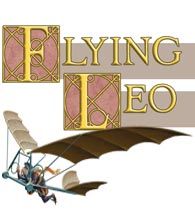Retro Replay Review
Gameplay
Flying Leo places you at the helm of Leonardo da Vinci’s inventive flying machines, offering two distinct control schemes: a wind-riding glider and a power-driven helicopter. The glider relies entirely on on-screen wind currents, which fluctuate in strength and direction, forcing you to plan each ascent and dive with precision. The helicopter, by contrast, supplements natural lift with vertical thrust at the click of a mouse, giving you more direct control but requiring careful energy management to avoid stalling.
Levels are designed around treasure collection and bonus pickups, with coins and treasure chests scattered across open skies and tucked into narrow caverns. Bonuses such as coin attractors and temporary invincibility spheres add a layer of strategy: should you detour to grab a magnet and amass coins more easily, or risk dodging cannon fire to push straight for the exit mirror? This tension between greed and survival keeps each run both exciting and unpredictable.
Enemy encounters include Pegasus, giant birds, serpents, and turret-style cannons that fill the air and ground with obstacles. Enemy patterns ramp up steadily, requiring you to learn attack rhythms and adjust flight paths on the fly. The risk of crashing into the ground or being shot down by a cannon adds an ever-present edge to exploration: smooth, confident piloting is rewarded, but even small mistakes can result in a dramatic, crash-landing reset.
Progression through levels culminates in navigating Leo through a colossal mirror, a simple yet elegant means of signifying completion and transition. While mirror passages occasionally feel narrow at high speeds, they provide a satisfying visual flourish when you clear a challenging stage. The mix of collection goals, environmental hazards, and mechanical mastery ensures that Flying Leo’s gameplay loop stays engaging from the first gentle breeze to the final boss-style showdown.
Graphics
Visually, Flying Leo strikes a harmonious balance between Renaissance aesthetics and vibrant, modern design. Leonardo’s glider and helicopter appear as detailed, hand-drawn models rendered in crisp polygons, complete with wood grain and canvas textures that evoke the historic prototypes. Backgrounds range from sunlit valleys to storm-tossed clouds, each layer parallax-scrolling to convey depth and speed.
Wind currents are clearly indicated by swirling, semi-transparent lines that pulse with color intensity, integrating style and function. These visual cues not only look graceful but also serve gameplay, enabling you to spot lift zones and wind tunnels at a glance. Particle effects—such as dust from cliffside gusts, spark trails behind cannonballs, and gleaming coin outlines—add polish without overwhelming the action.
Enemy designs meld mythological flair with steampunk accents. Pegasus sports metallic harnesses and glowing eyes, while serpents wind through the air with sinuous, articulated bodies. Cannons and mechanical bird-turrets showcase brass fittings and gear animations that feel both imaginative and consistent with Leonardo’s inventive spirit.
User interface elements are unobtrusive: a small coin counter and bonus-meter sit in the corners, leaving the center of the screen free for aerial acrobatics. Tutorial prompts appear as translucent parchment scrolls, guiding new pilots through basic controls without breaking immersion. Overall, the graphical presentation is both artistic and functional, supporting gameplay clarity while celebrating da Vinci’s visionary aesthetic.
Story
Flying Leo adopts a light narrative framework that casts you as Leonardo da Vinci himself, testing prototypes of his boldest flying designs. While the storyline doesn’t burden you with lengthy cutscenes, short in-game notes and sketches provide context for each level’s setting—whether you’re soaring above Tuscan hills or navigating windswept canyons in search of hidden treasure.
The story’s primary charm lies in its celebration of Renaissance innovation rather than intricate plot twists. Collecting coins and chests feels like cataloging discoveries, and bonus power-ups echo da Vinci’s tinkering ethos: temporary invincibility becomes an experimental force field, while coin attractors mirror magnetic theories he explored in his notebooks.
Occasional journal entries unlock between stages, offering whimsical anecdotes about flight trials gone awry or sketches of new machine concepts. These snippets add personality to the experience, reinforcing the idea that each level is a field test in Leonardo’s workshop in the sky.
Although Flying Leo doesn’t weave a deep narrative tapestry, its storytelling approach effectively frames the game’s objectives. By emphasizing exploration, creativity, and the thrill of invention, it invites players to share in da Vinci’s adventurous spirit without overcomplicating the core flying mechanics.
Overall Experience
Flying Leo delivers a satisfying blend of accessible controls, strategic resource management, and high-stakes aerial challenges. Whether you prefer the pure, wind-riding finesse of the glider or the assertive power of the helicopter, each flight feels distinct and rewarding. Level variety and escalating difficulty ensure that veteran pilots remain engaged, while clear tutorials and generous checkpointing welcome newcomers.
The game’s visual design and audio cues work in concert to evoke a sense of wonder and discovery. Ambient wind howls, creaking wooden beams, and triumphant chimes upon treasure pickup all contribute to an immersive atmosphere that honors da Vinci’s legacy. Although the narrative is light, it enhances rather than distracts, keeping the focus on flight mastery and exploration.
Minor drawbacks include occasional collision box quirks around tight mirror passages and a handful of levels where wind currents shift faster than expected. However, these moments are rare and often cast as welcome tests of skill rather than flaws. The overall pacing strikes a pleasing balance between leisurely exploration and adrenaline-fuelled dogfights.
In summary, Flying Leo is an engaging title for players who appreciate charming visuals, thoughtful physics-based flight, and a celebration of historical innovation. Its straightforward objectives, combined with layered mechanics and aesthetic polish, make it a compelling choice for both casual gamers and flight-sim enthusiasts alike. Buckle in, adjust your wings, and let Leonardo’s dreams of human flight carry you on an unforgettable airborne adventure.
 Retro Replay Retro Replay gaming reviews, news, emulation, geek stuff and more!
Retro Replay Retro Replay gaming reviews, news, emulation, geek stuff and more!









Reviews
There are no reviews yet.